surfresearch.com.au
 |
surfresearch.com.au
carey :
puerto rico contest, 1968
|
Paul Carey : Puerto Rico Notebook, 1968.
Carey, Paul: Puerile
Rico Notebook.
Surf International
Volume 2, Number 1, pages 18 to 22,
January 1969.
Introduction.
Note that the
original publication had the report for 8th November out of
sequence, and this has been adjusted, starting with page 19a,
then page 18 and 19b.
All the photographs are unaccredited, and some do not have
captions.
These
are most probably by the editor's brother and Australian
film-maker, Paul Witzig , or Paul Carey.
Also see:
1969 Paul Witzig
: World
Contest Peurto Rico.
Surf
International Vol. 2. No. 1 January 1969, pages 26
to 27.
and
Contest Results: 1968 World
Contest Puerto Rico.
Page 19a
Rincon.
7th November, 1968.
Tonight the
inaugural ceremony for the opening of the contest.
A genuine
happening!
Nobody
really held it, it just occurred, making the formal
oh so informal!
Furious last
minute sorting out a jumble of uniforms in a giant
man-handled package.
(Australia's
colours really apple-green, red and gold ?)
A bumpy bus
ride to the PIaza waiting expectantly, the biggest crowd
sInce the frenetIc electrons of two days before.
The Rincon
Highriders Motor-Cycle Club, downing a crystal clear rum or
two at the cafe, their Harley Davidsons gleaming chrome in a
line outside.
Were they
out for the destruction of the parade and the blood of the
competitors?
No.
They were
just going to lead the procession.
Draped in
fringed jackets, a clash in styles between Roy Rogers
and The Wild One, white lettering on blue with white fringes
identifying them to the bewildered surfers, they traversed
the few yards to the rallying point of the parade to follow,
in a kangaroo-leap of noisy, oily, rubber throwing,
intoxicating power.
The teams of surfers, Iined rather haphazardly behind their
reined-in escort, shambled the two hundred metres it took to
circumnavigate the Plaza.
The town band
beat and blew its instruments valiantly in the dim fluorescent
light of the plaza.
Keith Paull,
looking alternately astonished and amused, led the
Australians, who seemed dazed by the thundering open exhausts
of the Harleys just a few feet away.
All the town
was packed into the plaza, laughing, singing, crowded into the
steps of the rostrum, Iying precariously along the branches of
the thick dark trees, bursting into applause as the Puerto
Rican team approached its place on front of the dignitaries on
the rostrum.
Speeches were
made and the mayor, a glum, squat, dark man in a sober
coloured suit, gave a speech which sounded curiously sincere,
then presented the keys of the town of Rincon to a
gaily-suited, patrician Eduardo Arena.
Then the ceremony was over and the crowd broke for the Villa
Cofresi and the free white Puerto Rican rum which awaited
them. Surfers and band and motorcycle club rubbed shoulders in
me spirit of a small town ceremony which had been peculiar and
touching.
Yes.
Peculiarly
touching too.
Page 18
Black and white photograph: [Beach
spectators.]
Rincon. 8th November, 1968.
No swell to speak of today.
But there was
a draw and the heats and their composition have been decided.
Midget has no
opposition, at least no "name" opposition, unless one includes
Gordon Burgess of England in this category.
Ted Spencer
has Joey Cabell and Petie Johnson.
Robert
Conneeley is up against Corky Carroll. .
Wayne Lynch
faces Johnny Fain and James Blears from Hawaii.
Nat is not
expected to be too troubled by the local wonder Jorge Machuca,
though Ron Roman of New Zealand poses more problems.
And Russell
Hughes' main threats come from Fred Hemmings, Keith Paull's
from Reno Abellira.
Peter Drouyn
probably has drawn the toughest heat with Gary Propper,
Hawaii's Kevin Johns and Rodney Sumpter.
Luckily all
countries were amenable to using eight surfers, so Tony
Olsen's pleas on Australia's behalf bore fruit.
It was decided
to have a big wave contest if there should be big waves,
otherwise the one contest would decide all.
At the moment,
the presence of big waves in Puerto Rico seems highly
legendary.
We've been
here for five weeks and have seen only one swell slightly over
five feet.
More free
white Puerto Rican rum courtesy of the Bonnie Bell cosmetic
company.
There are some
surfers who are definitely not praying for surf tomorrow.
Rincon,
9th November, 1968.
The women's
contest was held in what r seemed like anti-climatic haste,
considering after all that it was the contest for the best
woman surfer
in the world.
A few quick
heats and a semi-final in good quality, 3-4 foot Domes surf,
an hour-long lunch which allowed the wind to turn on-shore,
and Margo Godfrey was the new women's champion.
Gail Couper
and Joyce Hoffman both were knocked out of the proceedings in
their semi-finals, and the 15 year old Santa Barbara
schoolgirl, the popular and sentimental choice, walked it in.
Phyllis
O'Donnell, from Queensland but working in Dewey Weber's shop,
apparently, as someone said, ripening with age, came third and
surfed ...
Page 19b
... extremely
well.
Sharon Webber
from Hawaii was second.
This second
place seemed a little ominous, since Martha Sun, also from
Hawaii, ripped, whereas Sharon just made waves but the length
of her waves seemed to take it out for her.
All the girls,
with the exception of Martha Sun and, at the end, Margo,
seemed nervous and were inclined to play things a little safe.
This seemed especially true of Gail Couper.
Rincon.
10th November, 1968.
Well, Domes
was the spot again, this time for the elimination heats of the
men's.
It must be the
firsttime that a surfing contest, let alone the world contest,
has been held on U.S. Government property, for the place known
as Domes is a nuclear hot-water power plant, and is named, or
rather nicknamed, after the 2001- looking rust-streaked silver
dome which houses its innards, nestled incongruously among the
deep-green palm trees.
The reason
that anyone is allowed on this site is because the plant is
being closed down.
In a small
swell, Domes offers the best quality small surf in the area.
But such slow
waves!
The Hawaiians
especially had troubles (though one wouldn't have thought so
from the judging).
The first
Australian to get knocked out of the contest was a sick Ted
Spencer, who was beaten by Petie Johnson and Joey Cabell in a
first two out of six, five waves in twenty minutes contest.
Cabell got
better waves and longer rides and did nought, Ted's waves were
not quite as good but he did surf them.
Rob Conneeley
was the next out.
After ten
minutes he was still waiting outside with no waves caught; he
finished with only four.
The Cork got
ten.
Peter Drouyn's
fate was similar though he didn't surf as well as Conneeley,
who had been in his best form.
Midget, Nat,
Wayne Lynch and Keith Paull (who was also sick) won their
heats, and Russell was second in his to Hemmings, leaving
Australia with 5 out of 8 into the quarter finals.
Rolf Arness
was the judges' most glaring omission, going down to Ben Aipa
and Felipe Pomar for no apparent reason.
He looked to
Australian eyes the best surfer in his heat.
Page 20
Black and white photographs.
Top: [David Nuuhiwa top turn, white competition shirt.]
Bottom: [Domes
landscap.]
Idly reflecting over the day's activities, it
seemed odd that it probably cost each Australian eliminated
from the contest $75 a surfing minute, which wasn't really
very good value.
Twenty
minutes, five waves, two out of six and see you later, boys.
Rather
cursory.
Perhaps the
system used in the Australian contest, of two separate
contests, best 6 accumulated points to be the finalists is
better, eliminating as it does the luck of the draw, at least
as far as opponents are concerned.
Many of the
contestants seemed to have travelled a little too far for the
justice they received.
One could
argue that that's show business, but to me it doesn't seem
good enough. Rincon. 11th
November, 1968.
No swell.
Tandem and
paddling events.
An Australian
team won a Mack Sennett Paddling relay.
Rincon.
12th November, 1968.
Again no
swell.
After two
hours the committee of the seven major competing nations made
the decision to have the contest on stand-by.
The 5,000
metre paddle race took place instead.
It was won by
a Californian who had been brought from California to paddle,
together with two others who came second and third. They had
special paddle boards.
Peter Drouyn
was 6th on a normal board.
Felipe Pomar
was the first surfer to finish.
Rincon.
13th November, 1968.
No swell for the third day.
If nothing
happens tomorrow then the stage is set for a gigantic farce.
The surfers
could forgive the bad and inadequate food and the poor
accommodation, and the high prices and the thefts, only if
there is swell.
We met Pina,
beautiful wife of the Peruvian Judge, coming out of the
church.
We jokingly
asked her if she was praying for surf, and in all seriousness
she said she was.
She was so
sincere we stopped smiling and mumbled that it was a good
idea.
Rincon.
14th November, 1968.
The last day.
Somebody up
there likes us.
Domes was 6-8
ft. and for once the Committee sprang into action.
The quarter
finals , five waves in half an ...
Page 21
Black and white photographs.
Left : [Street
scene with motor bike.]
Right: [Beach
scene.]
hour, were run off in what seemed staccato
precision.
Keith Paull
was eliminated.
He didn't get
the waves and that was that.
It was a
disappointment for one of the most popular amoung the
Australians.
The others,
Nat, Wayne and Midget, won.
Russell was
second.
Into the semi
finals without a break.
Russell, who
had been in the last quarter final, was in the first
semifinal, which was an advantage.
Even though he
had been tired after paddling through very heavy white water,
he encountered the first surf which was big and wind-blown,
and had got used to it, whereas his semifinal opponents
including Hemmings again, had to accustom themselves to the
poor conditions after the good quality of the morning.
And Russell
was second again and into the final.
Midget and Nat
both won their semis.
Many of the
names went crashing down.
Lynch,
Nuuhiwa, Carroll, Purpus, Cabell.
The last-names
(sic) couldn't extract power from the thick but
still-slow Domes waves, so the expected duel between him and
Nat had to wait.
The finalists
were then:
Australia;
Midget, Russell, Nat
Hawaii;
Hemmings, Reno Abellira
California;
Mike Doyle.
Doyle had not
been chosen in the Californian team originally but was taken
as the big wave reserve.
He got to the
final with just good surfing and extremely good use of the
conditions, as well as good contest tactics.
Midget is his
Australian equivalent.
Russell Hughes
vindicated the judgement of his supporters.
By the time
the last semi-finals has been completed, the surf at Domes was
too wind-affected to be worthy of a world contest final.
On this
occasion it took the contest committee two hours to decide to
move to Rincon itself (known as Dona Maria's) where the
slightly more westerly direction off (sic) the coast
afforded the surf protection from the wind.
And, after an
hour which it took to move the contest (it took the contest
only half an hour, but ABC wide world of sports T.V. wasn't
able to set up in that time, so could we have a world
championship without ABC? No, we couldn't.)
The surf was
very thick, hollow and still glassy.
A lot of waves
were closing. out so you had to pick and choose.
Fred ...
Page 22
Photograph: [ Nat Young and "The Young
Weber" board.]
The text is
superimposed over the photograph.
Hemmings had to straighten out on the waves,
dropped in on four others, got five or six perfectly
respectable but highly uninteresting long rides, and won the
Contest.
Nat tried some
very difficult things, brought off half and blew the rest, and
was fourth.
Midget was
impeccable, got long rides, close to the curl, came off the
top once or twice, and pulled a beautiful cut-back down the
steep face of a wave which everyone thought would get him
nailed, yet he got enough power out of the bottom turn to make
the eight foot section.
That was
memorable.
Surfers on the
beach picked him as winner but they were wrong.
Russell was
beautiful.
He got long
rides as least as long as right-said-Fred, and got two tubes
to boot, and they were big waves to disappear in.
But he came
third.
Mike Doyle
made good waves, surfed very well and close to the curl, tried
a few neat top-turns, and was fifth.
Little sixteen
year old Reno Abellira didn't get a lot of waves and blew a
few, but his tiny little surfing water-ski propelled his
faster than anyone else, and he was exciting on the waves or
part-waves he caught.
He took off on
the biggest wave of the day and it was exciting to see him
move his legs in telescope fashion absorbing the shock from
the lumps across the face of the wave, miraculously attached
to his tiny pin-tail.
Reno was
sixth.
So the contest
was over, Hawaii was stoked, the crowd was surprised, but
there's really no reason why a world contest should produce
more consistent results than any other contest.
1. F. Hemlngs
Hawaii
2. B. Farrelly
Australia
3. R. Hughes
Australia
4. R. Young
Australia
5. M. Doyle
West Coast
6. R. Abellira
Hawaii
It seems to me
that the reception at the Mayagues Hilton after the final,
more or less encapsulated the feeling which the contest
produced.
Despite the
cons, the pros seemed to finish first.
From the start
it was obvious that to the Puerto Rican organizers, surflng
came second.
Surfers
interested were subjugated to those of the Department of
Tourism, namely development for ...
Page 23
|
[Nat Young top turn.]
|
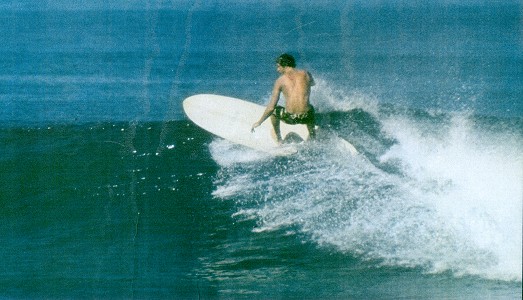
|
Page 24
tourists of
the Puerto Rican West Coast.
Thus ABC-TV
(U.S.A.) were given prime importance, since they were the
instrument of publicity.
The source
of publicity, surfing could well have been mountain climbing
or ping-pong or whatever other potential the Rincon area
might have offered.
That its
surfing potential was greater than any other, was a mere
whim of nature.
In this
over-riding atmosphere, the food and accommodation and
organization and cost of living were all bad.
Security was
worse.
Nearly 1/3
of the boards taken to the contest were, stolen.
Dr. Don
James and another photographer, Peter Dixon, had all their
photographic gear stolen and thus left before the final.
Yet the
Puerto Ricans themselves were extremely friendly and this
helped make up for the cupidity of a few.
All the bad
things, together with the lack of the surf everyone had
promised, irritated and annoyed the surfers, but at the same
time united them, so that the nuisance value of
unpleasantries tended to be met and balanced out by a kind
of solidarity among all surfers present.
A type of
communal feeling existed which seemed to make even the contest
result unimportant.
At the
Prize-giving dinner, even right-said- Fred pin pointed this in
his victory speech, while people all around were exchanging
ideas, planning projects, new board and help for each other in
Hawaii.
In Puerto
Rico, if someone had a board stolen, everyone was willing to
lend him another.
If an American
forgot something, an Australian would drive him back to get
it.
If a Hawaiian
dinged his board, a Panamanian would patch it for him.
Things like
that.
And once
again, the Mayor of Rincon pulled off a master-coup of a
speech.
You could see
he was speaking Spanish slowly so that even Anglo-Saxons could
try to pick up what he was saying.
Then, in
extremely broken and slow English, he said that Rincon ,was
the home of everyone there.
And everyone
there knew that he, meant it, and what's more, they believed
it.
Left:
[Russell
Hughes and friend.]
Right:
[Midget
Farrelly and board, two others, one with board.]
Note
the rubbish scattered on the beach.
|
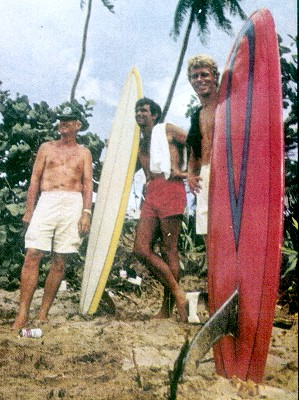
|
Page 25
[Unknown, bottom turn.]
|
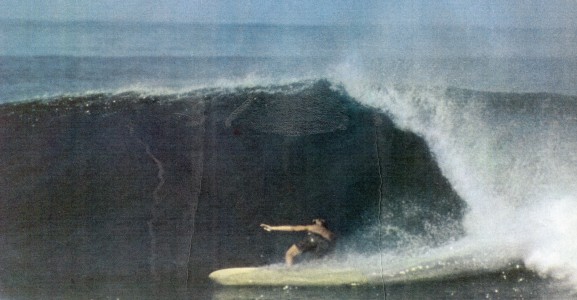 |
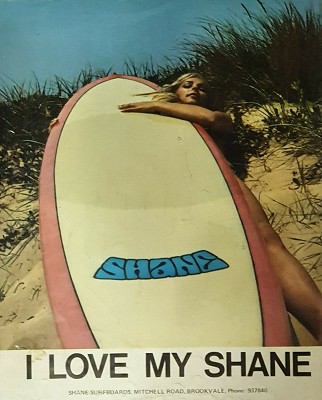 |
Surf International
Volume 2, Number 1.
January 1969.
Back cover:
Shane Surfboards
|
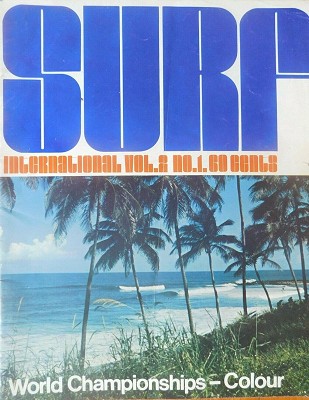
|

surfresearch.com.au
Geoff Cater (2011-2020) :
Paul Carey : Puerto Rico Notebook, 1968.
http://www.surfresearch.com.au/1969_Carey_1968_WC_PR_SurfInt.html







